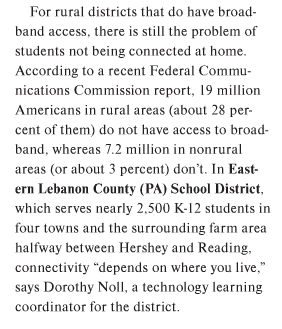Multiplication problem
A sixth grader in rural Pennsylvania — we’ll call her Hayley — is excited to have an assignment she can do online. Her new social studies teacher has asked her group to create a multimedia presentation explaining the impact of steam power on the economics of 19th century Pennsylvania. The group has two class periods to work together in school and must find the remaining time outside of class. Hayley is one of the 28%*
A second grader in urban anywhere– we’ll call him Sam — needs practice with sight words and phonics sounds. His parents are learning English and are very eager for their son to do well in school. Sam is one of the 3%*
Neither Hayley nor Sam has Internet access at home except for Hayley’s family cell phone. Their teachers are very understanding and offer an extra 15 minutes during recess and a half hour before or after school for them to use a computer in the classroom, lab, or library. Sometimes Hayley can even work on her project using the family phone, though she finds it more fun to try texting. The local public library also has a computer for students to use. Problem solved, right?
Now fast forward two or three years. Sam is in fifth grade, and Hayley is in high school. Their teachers have had extensive inservice and have enthusiastically adopted new teaching strategies. Finally, the world of teaching and learning has moved into the 21st century. Hayley’s high school is encouraging teachers to use collaborative online tools which it has subscribed to, and Sam’s elementary teachers are pressing all students to write on their blogs at least once a week. In a given week, Hayley must complete a group science project, an English blog post, and submit examples of algebra use in the real world. Total online time needed outside of class: at least 5 hours. Sam struggles to word process his longer language arts assignments and spends every recess indoors. The public library has reduced its evening hours to Thursdays only and is never open on Sundays. To make matters worse, the library is a ten mile drive from Hayley’s home and a long bus ride for Sam’s mom and her three other children.
Sam’s parents try to share their new cell phone, but Sam and his siblings compete for a few minutes here or there. The phone is also their family lifeline for their dad’s odd jobs. Sam’s school faculty is considering eliminating online assignments, since so many students lack access. Scheduling the computer time for so many creative ideas and reinforcement activities is too much of a burden on teachers, and there is no one else to help. Sam and his school may simply be “left behind.” Total population of elementary kids needing computer time: 200, times three kids per family… and we have a problem.
Hayley’s school must decide whether to shift back to paper/pencil tasks for all or to ration teachers’ online assignments. There simply are not enough places for so many disconnected students to complete connected assignments. And the cable and phone companies have no plans to expand coverage in such a thinly populated rural area where there is no chance to make a profit. Total disconnected population of 250 times 5 hours each = 1250 needed hours of computer time per week.
Sam and Hayley are individual examples of a massive chasm forming beneath the surface of 21st century learning. The “haves” schools (those with a small number of disconnected students) move forward in technology adoption, professional development, and effective use of the tools for learning. The “have nots” (those with many disconnecteds and/or many assignments times fewer disconnecteds) are trying to keep up. Even if successful teacher PD wins over the rural teachers, the students of the “have not” schools are still doomed by their local infrastructure.
Small problems grow. Cracks get bigger. Is anyone watching the chasm beneath the feet of our best efforts?
* related info from T.H.E. Journal http://www.nxtbook.com/nxtbooks/1105/journal_201110/#/22/OnePage :





[…] is considering eliminating online assignments, since so many students lack access. Scheduling the Computer time for so many creative ideas and reinforcement activities is too much of a burden on teachers, […]
Pingback by Computer In The Classroom | Information Technology — November 13, 2011 @ 12:10 pm